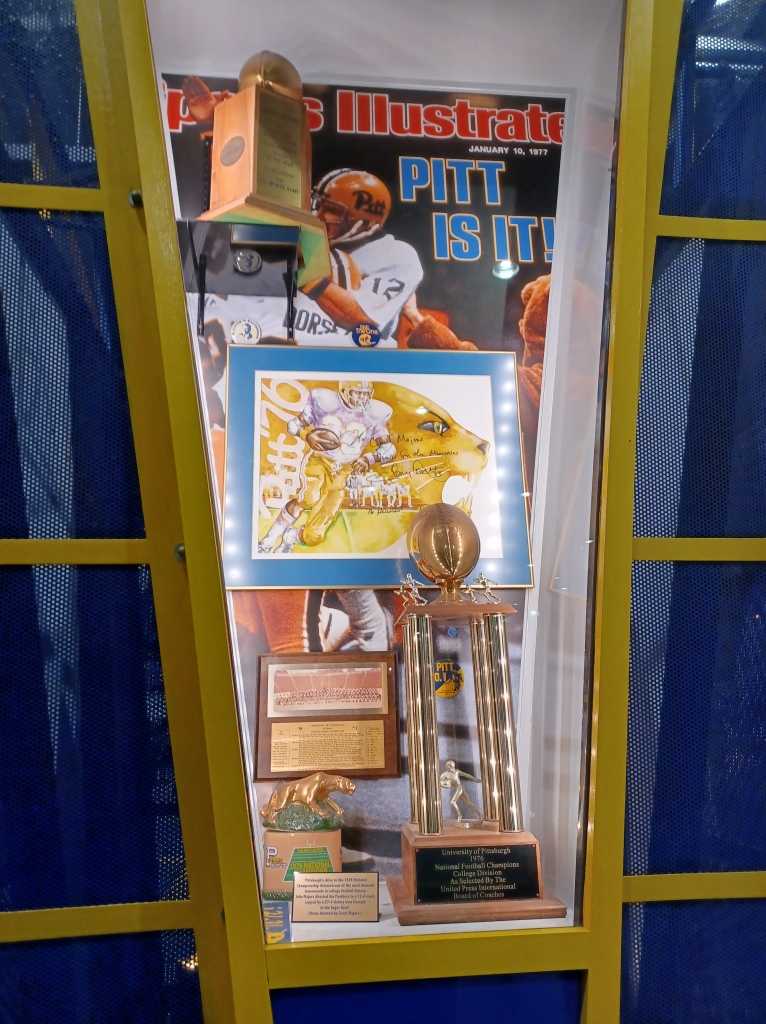Has playing football off-campus helped Pitt football? There’s no denying playing on the North Shore has its advantages in terms of parking, traffic and accessibility more so than playing in Oakland, but the gameday experience just isn’t the same off campus. Alumni love to visit where they spent their college years and all that rekindled, feel good nostalgia is lost by playing off campus. You can’t even see the Cathedral of Learning from the North Shore.
Do you think college students prefer to wait in line to ride a school bus, like an elementary student in grade school, to and from Acrisure Stadium as opposed to being able to walk to a nearby on-campus stadium not long before and after a game?
A selling point to the Pitt community on moving to an off-campus stadium shared with the Pittsburgh Steelers was that football recruiting would improve with the belief that new facilities shared with the Steelers would help sell Pitt to high school recruits. Better recruiting should result in increased winning and better results. Recruits certainly aren’t drawn to poor, outdated and non-maintained facilities, such as Pitt Stadium was, but how many Top 25 recruiting classes has Pitt football had since playing off campus? Just two since 2002. Two. Playing off-campus in shared facilities with an NFL team has not attracted the country’s best recruits as promised.
In the past 22 years that recruiting classes have been ranked, Pitt’s recruiting has averaged 41st in the country. Pitt’s 2023 recruiting class according to Rivals is ranked 52nd. Pitt had only five recruiting classes finish in the top 30 of Rivals’ recruiting rankings with the highest being ranked 21st in 2006 and also in 2021, and had three top-30 recruiting classes from 2006 through 2008.
The promised notion that sharing a stadium with the NFL’s Pittsburgh Steelers would be a huge recruiting advantage has been proven to not be true.
Pitt football broke attendance records for the city of Pittsburgh playing off-campus first against Penn State in 2016 at Heinz Field with 69,983 spectators and then again against West Virginia in 2022 at Acrisure Stadium with 70,622, but that’s largely due to a larger stadium capacity and who they played and those visiting fan bases being so close to travel. In comparison, the highest attendance at Pitt Stadium was 68,918 back in 1938 against Fordham.
Despite having one of the lower priced season tickets among Power 5 schools through the years, Pitt had attendance issues playing both on and off-campus.
In terms of attendance, perhaps playing in a larger stadium in a more accessible location has upped fan attendance, but has it helped where it matters most, in wins and losses? Creating a positive atmosphere for Pitt and a disruptive negative one for opponents certainly adds to a team’s chances of winning.
In terms of wins and losses, how has Pitt playing off-campus compared to when Pitt played on-campus? Pitt has played off-campus 24 seasons since the year 2000 playing in Three Rivers Stadium, Heinz Field and now Acrisure Stadium. Let’s compare how Pitt has fared in those 24 seasons playing off-campus (2000-2023) to the previous 24 years playing on-campus (1976-1999) at Pitt Stadium.
Since 1976, Pitt has an overall record of 323-249-7 for a winning percentage of .564. Pitt’s record at Pitt Stadium from 1976-1999 was 87-55-2 for a winning percentage of .611. Pitt’s record at the North Shore stadiums is 104-55 for a winning percentage of .654. In case you’re curious, Pitt’s record away from home since 1976 is 132-139-5 for a winning percentage of .487.
Pitt’s record at the North Shore stadiums includes the 1976 game against Penn State as well as the 1982 game against North Carolina and the 1999 game versus West Virginia. In 2000, Pitt played all their home games at Three Rivers Stadium before playing at Heinz Field.
As one would expect, Pitt has a better record at home than on the road. It would be troubling if they didn’t. Pitt has a better winning percentage in their first 24 seasons off-campus as compared to their last 24 seasons on-campus, a difference of .043.
In looking at how Pitt has fared against top 20 teams, how has playing off-campus compared to when Pitt played on-campus?
Since 1976, Pitt’s overall record against top 20 teams at home is 18-39 for a winning percentage of .316. Pitt’s record against top 20 teams on the road is 16-47-2 for a winning percentage of .262. As one would expect, Pitt has a better winning percentage against top 20 teams at home than on the road. The numbers bear out that playing at home in front of the home crowd is a definite advantage.
Pitt’s record in their last 24 seasons at Pitt Stadium against top 20 teams was 9-22 for a winning percentage of .290. Pitt’s record against top 20 teams at the North Shore stadiums is 9-17 for a winning percentage of .346. Playing at the North Shore Stadiums has increased Pitt’s winning percentage against top 20 teams as compared to the last 24 seasons at Pitt Stadium.
As the won-loss records show, Pitt has fared better playing at the North Shore stadiums against top 20 teams in using a 48-year data set for playing on-campus versus playing off-campus.
As for expenditures and revenue, I’ll leave that to the financial bean counters, but one would think there are financial reasons, for highly-educated professional administrators at colleges and universities such as the University of Cincinnati, Minnesota, Tulane, and the University of South Florida to decide to forego sharing a professional stadium in their city and build a new on-campus stadium and/or renovate their current on-campus stadium rather than play football off-campus in a professional football stadium.
Has playing off-campus the past 24 seasons significantly improved Pitt’s football program? This year’s 3-9 season certainly doesn’t help that argument any, but the won-loss record comparison would indicate Pitt has improved playing at the newer, more modern North Shore stadiums as compared to a poorly-maintained Pitt Stadium.
However, the last time Pitt football finished ranked in the top 10, Pitt football played on-campus. The last time Pitt football didn’t lose three games in a season, Pitt football played on-campus. The last time Pitt football won a major bowl game, Pitt football played, you guessed it, on campus. Could that all be just a coincidence?

John Baranowski is a writer for DreamBackfield, sports historian and contributor to newspapers, sports publications, and sports websites.


